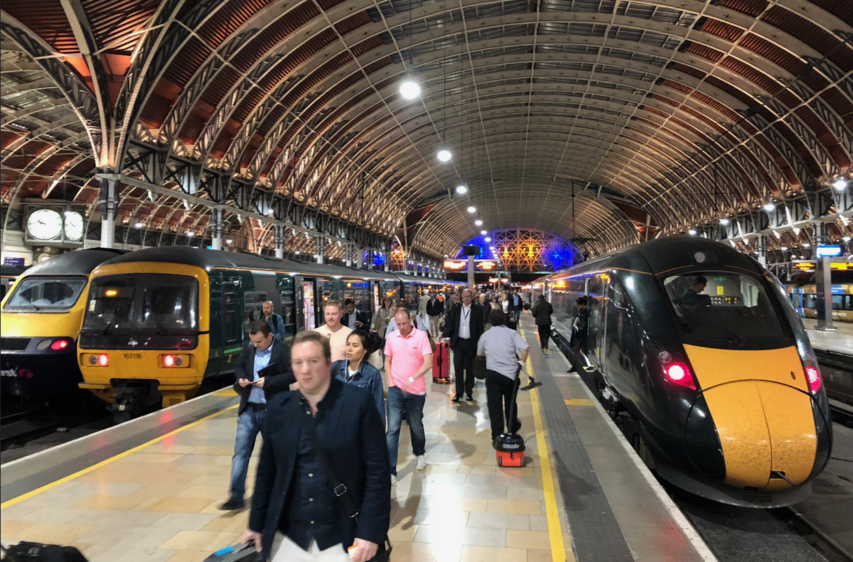Other than preserved steam train passenger trips, the last time I took a train in Britain was during the “Winter of Discontent”, and it was a grim experience indeed. Recently, Malcolm Kenton purchased a First Class BritRail Pass and did some extensive travels on many of the passenger services (averaging over 250 miles per day over 12 days). He said he understands why the British complain about on-time arrivals, but compared to American passenger trains, he clearly felt he was in a railway wonderland:

10:00 PM on a Tuesday, May 15, at London’s magnificent Paddington Station. At right, a Great Western Railway
Hitachi dual-mode train has just arrived from points southwest, with a Great Western DMU train across the platform.
Photo by Malcolm Kenton
The Brits have a habit of complaining about their trains. As I experienced, their on-time performance often falls short of Swiss standards (though is excellent by American standards), ticket prices are continually increasing, and service frequencies and span on some lines aren’t what they could be. But it’s hard for someone who’s used to a country where even major cities are served by just one train a day, if that, to knock a system that provides at least three daily frequencies to even the least densely populated lines. If this is what remains after the infamous early 1960s Beeching cuts, which saw the abandonment of many secondary lines, then what existed before must have been absolutely mind-boggling.
[…]
The regular National Rail trains I rode were about evenly split between electric and diesel power. Most of the lines emanating within a 100-mile radius of London are electrified — both the East Coast and West Coast mains boast catenary as far as Edinburgh and Glasgow from London, and several other lines have third-rail power, including the South Western trains between London Waterloo and Weymouth via Southampton, which I rode — the world’s longest continuous third rail-electrified railway at 136 miles, whose electrification was completed in 1988. By contrast, America’s longest electrified railroad is only 57 miles: Metro-North’s Harlem Line from Grand Central Terminal to Southeast, N.Y. Trips of up to 200 miles on electrified lines tend to be covered by Electric Multiple Unit trainsets, while electric locomotive-hauled sets cover longer runs.
Top speeds for expresses on the electrified mains range from 100 to 125 MPH, akin to Regionals on Amtrak’s Northeast Corridor. Older equipment is usually limited to 80 to 90 MPH. On less busy branch lines, speeds top out between 40 and 70 MPH depending on track condition. Some of these lines are dark territory and some still use semaphore signals and manually-operated switch towers (signal boxes in British parlance).
Catenary electrification is working its way westward on the Great Western main line towards Cornwall, but long-distance expresses on this line use either 1990s-built High-Speed Train trainsets powered by diesel locomotives on both ends or two-year-old Hitachi dual-mode (catenary electric and diesel) multiple unit trainsets. Most services on less busy lines, however, are provided by Diesel Multiple Unit trainsets of varying vintages and configurations, often of just one or two cars. ScotRail’s rural services, including the five-hour run Sam and I took from Glasgow to Mallaig, all use DMUs.
Of the ten different branded National Rail services I sampled, I was most impressed with Virgin Trains, Great Western and Chiltern Railways. I took Virgin’s expresses on both the East and West Coast main lines and both offered a comfortable First Class product with hot meals and alcohol included, similar to Acela First Class. Great Western’s First Class seats were the most comfortable and the color schemes and seat arrangements the most attractive, and the food service included sandwiches as well as snacks, coffee, tea, sodas and still or sparkling water. On most trains traveling for more than one hour, there is food and beverage service from a cart. In most cases, First Class passengers get one complimentary snack (such as pretzels, fruit, crisps (potato chips in British parlance), candies, cookies and pastries) and one drink each time the cart passes through the coach.



